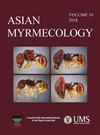Comparing different methods to assess weaver ant abundance in plantation trees
IF 1.2
4区 农林科学
Q2 ENTOMOLOGY
引用次数: 7
Abstract
Weaver ants (Oecophylla spp.) are widely used as effective biological control agents. In order to optimize their use, ant abundance needs to be tracked. As several methods have been used to estimate ant abundance on plantation trees, abundances are not comparable between studies and no guideline is available on which method to apply in a particular study. This study compared four existing methods: three methods based on the number of ant trails on the main branches of a tree (called the Peng 1, Peng 2 and Offenberg index) and one method based on the number of ant nests per tree. Branch indices did not produce equal scores and cannot be compared directly. The Peng 1 index was the fastest to assess, but showed only limited seasonal fluctuations when ant abundance was high, because it approached its upper limit. The Peng 2 and Offenberg indices were lower and not close to the upper limit and therefore showed fluctuations throughout the season. The numbers of nests showed high fluctuations unlikely to reflect ant abundance, but rather reflected nest building behaviour influenced by tree phenology. In conclusion, nest counting is not recommended, whereas the Peng 1 index can track dynamics at low ant abundance and the Peng 2 and Offenberg indices can be used in most situations. (Resume d'auteur)人工林中织蚁丰度评价方法的比较
织蚁(Oecophylla spp.)作为一种有效的生物防治剂被广泛使用。为了优化它们的使用,需要跟踪蚂蚁的丰度。由于已经使用了几种方法来估计人工林上的蚂蚁丰度,因此研究之间的丰度没有可比性,并且没有指导方针可用于特定研究的哪种方法。本研究比较了现有的四种方法:三种方法基于一棵树的主树枝上的蚂蚁足迹数量(称为Peng 1, Peng 2和Offenberg指数),一种方法基于每棵树的蚂蚁巢穴数量。分支指数不能产生相等的分数,不能直接比较。Peng 1指数的评估速度最快,但仅在蚂蚁丰度高时显示有限的季节性波动,因为它接近其上限。Peng 2指数和Offenberg指数较低,不接近上限,因此在整个季节都有波动。巢的数量表现出高波动,不太可能反映蚂蚁的丰度,而是反映了受树木物候影响的筑巢行为。综上所述,巢计数不推荐使用,而Peng 1指数可以在蚂蚁丰度低的情况下跟踪动态,Peng 2和Offenberg指数可以在大多数情况下使用。(简历d 'auteur)
本文章由计算机程序翻译,如有差异,请以英文原文为准。
求助全文
约1分钟内获得全文
求助全文
来源期刊

Asian Myrmecology
ENTOMOLOGY-
CiteScore
1.70
自引率
12.50%
发文量
0
期刊介绍:
ASIAN MYRMECOLOGY is a peer-reviewed, online-only journal dedicated to the study of Asian ants. Articles are published continuously, immediately upon final acceptance. Asian Myrmecology publishes original research papers on ants in or from Asia, or with regional or global importance. All areas of modern ant research are covered, including:
- Taxonomy
- Biogeography
- Ecology
- Behaviour
- Life-history
- Ethology
- Genetics
- Conservation evaluation
- Applied myrmecology
 求助内容:
求助内容: 应助结果提醒方式:
应助结果提醒方式:


